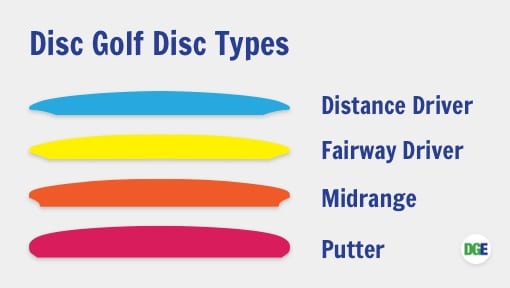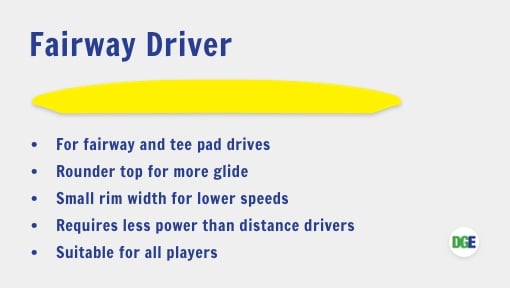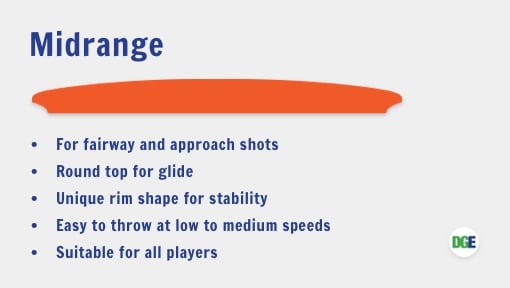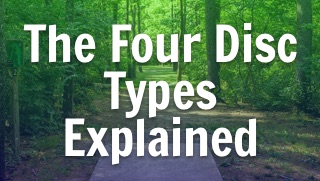
There are four main disc types used in the sport of disc golf.
- Distance Drivers
- Fairway Driver
- Mid-Range
- Putters

Why These Four Types of discs?
The four types of disc golf molds each carry unique flight characteristics that are needed to shape different shots for various course layouts and obstacles.
The way the disc is shaped, the depth of the rim, the top of the disc, and the plastic from which it is made all play major factors in how the disc reacts out of your hand.
Some discs go further, some drop out of the air quickly, some get a lot of lift. This all has to do with the disc type that you’re throwing and the disc shape.
Not only that, but the conditions on the course such as the wind, trees, and ground type all play a part in selecting the right disc for each throw you’re making. Having a bag full of diversity starts with understanding just why we have these four different disc shapes and types.
Most common uses of the different disc golf discs:
- Distance Drivers: Used for gaining maximum distance off the tee pad.
- Fairway Drivers: Used for driving and fairway throws where more control and less distance is needed.
- Mid-range: Used for approaching the basket where more control over speed, height, precision is needed.
- Putters: Used to putt into the basket and for approaching as well.
Distance Drivers

- Use: Distance drivers are used for gaining maximum distance from the tee pad or the fairway. Drivers can be thrown on average from 300-400 feet and even more in the right conditions and from an advanced player. Drivers come in various weights, plastic types, and disc stability giving the thrower a range of shot options and confidence in various conditions.
- Flight Path: Drivers have many flight paths they can achieve depending on what angle the discs are released. Distance drivers usually will give the player the most option of flight paths because of the various speeds, turn, and fade in the many discs available.
- Speed: Distance drivers require a good amount of speed on the disc to react in their intended manner. Most distance drivers range from speed 10 and up. Distance drivers can be a great choice for throwing into a strong headwind because that headwind increases the airspeed around the disc helping to bring it up to speed.
- Rim Shape: The rim of distance drivers is sharp allowing them to cut through the air and maintaining their disc speed, allowing for max distance.
- Rim Width: Distance drivers have wide rims allowing for more weight on the outside of the disc. This helps to keep the disc spinning longer and keeping its flight path. This rim width does make for a trick grip for beginners.
- Flight Plate: The flight plate of the top of the disc is usually flatter than most disc allowing it to get the right amount of glide for the distance needed.
- Beginner tips: The speeds required for distance drivers can be difficult for a beginner player to reach and it is often recommended for beginners to use fairway drivers and or mid-range discs for driving until they can improve their arm speed.
If you’re interested in my favorite drivers check out this article…Best Disc Golf Drivers
Beginner Tip: The speeds required for distance drivers can be difficult for a beginner player to reach. It is often recommended for beginners to use fairway drivers and or mid-range discs for driving until they can improve their arm speed.
Fairway Drivers

- Use: Fairway drivers are also used for driving but will achieve less speed and distance than the high-speed drivers. This makes them perfect for driving through the wooded courses where you need more control and for throwing from the fairway where you need less distance.
- Flight Path: The fight path and options are similar to distance drivers. Due to the various stabilities, fairway drivers come in, you can put the discs on many angles to achieve great results. One benefit fairways drivers have of distance drivers is the control over the fight path n wooded course or hole with many obstacles and a low ceiling due to trees.
- Speed: Fairway drives usually fall in between 7 and 9 when it comes to speed. These lower speeds allow you to focus on control and shot placement which is easier when you are exerting less force in your throw. Lower speed drivers such as fairway drivers are best for beginners wanting to improve their driving distances.
- Rim Shape: While they have a sharp edge profile they have a little more curve in their rim. The shape of the fairway driver makes it easy to grip and get a nice snap from your release, improving your distance.
- Rim Width: The width of the rims is smaller than distance drivers as well once again making them easier to grip. Your grip is important when it comes to controlling the discs flight angles and shot shaping.
- Top Plate: The flight plate is a little rounder than the distance drivers allowing them to attain great glide control. A slight rounder flight plate makes it easier to grip as well.
- Beginner Tip: The shape of the fairway driver makes it easy to grip and get a nice snap from your release, improving your distance.
Beginner Tip: The shape of the fairway driver makes it easy to grip and get a nice snap from your release, improving your distance.
Mid-Range Discs

- Use: Mid-range discs are generally used as you’re approaching the basket. They allow you to have the most control of its distance and the angle at which the disc lands on the ground. Mid-range discs can also be used for driving when the wind is an issue or if you need to keep the disc low because of overhanging trees.
- Flight Path: Mid-range discs offer a little less in terms of various flight paths. While some mids come with very overstable or very understandable flight numbers, many times after you get that angle you’re looking for in the flight, the disc flattens out on its flight and continues holding that line till it finishes.
- Speed: Mid-range discs come in speeds of 4 to 5 making them easy to throw for beginners and pros alike. When throwing a mid-range disc accuracy is usually an important goal. The low speed of mids makes them perfect for control shots on the green and in wooded courses.
- Rim Shape: The rim of Mids usually has a blunt tip and a concaved bottom half of the rim. These shapes can change from various manufactures. This shape allows the disc to glide slowly through the air allowing for control by cutting down its speed.
- Rim Width: The width of the mids rim is usually small and make the easy to get a good grip on them.
- Top Plate: The top plate is flat to round. This usually allows for less glide in the disc resulting in more control of how high it goes. This flat or slightly round shape allows for different grips on the disc such as a fan-grip or other variations.
- Beginner Tip: The top plate is flat to round. This usually allows for less glide in the disc resulting in more control of how high it goes.
If you’re interested in my favorite mid-range discs check out this article…Top 7 Disc Golf Mid Range Discs
Beginner Tip: The top plate is flat to round. This usually allows for less glide in the disc resulting in more control of how high it goes.
Putters

- Use: Putters are often called putt-and-approach discs because while they’re used for putting, they make the perfect disc when you’re getting close to the basket and need it to sit flat on the ground. Putters make great approach disc because they have fewer chances of skipping past your intended landing zone and sitting flat allows them to drop fast for accuracy. The most use you’ll get out of your putters is for actually putting. You’ll get the most consistency putting with your putters than any other discs.
- Flight Path: While you can force a putter to flip over or throw it on a hyzer, they have the least varying flight path of all the disc molds. This helps with accuracy and getting the disc to fly straight and into the basket.
- Speed: Putters range from 1 to 3 in terms of speed. You can still gain great distance with a putter due to their stability. Driving and learning to throw putters is probably one of the most popular beginner’s tips out there.
- Rim Shape: Putters have the roundest shape of all the discs. This allows for a comfortable grip and ease of release. Some putters are made with a bead. This is not preferred by all players so get a feel for whether you like a bead or bead-less putter.
- Rim Width: Putters have very little of when it comes to the with or their rims. They usually have a rounded to the flat bottom half of the rim.
- Top Plate: Putter comes with flat or rounded flight plates. A rounder plate will allow for more lift while a flat flight plate will allow for more wind control and faster drop at the end of its flight.
- Beginner Tip: Putters range from 1 to 3 in terms of speed. You can still gain great distance with a putter due to their stability. Driving and learning to throw putters is probably one of the most popular beginner’s tips out there.
Beginner Tip: Putters range from 1 to 3 in terms of speed. You can still gain great distance with a putter due to their stability. Driving and learning to throw putters is probably one of the most popular beginner’s tips out there.
Disc Shape
Disc shape plays the biggest factor in how a disc flies after it’s thrown. In general, pointy or sharp discs cut through the air more and require more speed to fly properly. Round or flat discs require less speed for a nice flight. Round topped discs or “domey” disc will get more lift from the wind.
Always seek out discs shapes that fit your hands and your grip style. A disc that you can’t grip correctly will either leave your hand too early or will get stuck in your hands, a term we call “grip-lock.”
Disc Speed
All discs require different speeds for optimal flights. The speed of a disc is not only how fast you threw it but also the wind that is going against it as well. A headwind will technically speed u the disc and a tailwind will slow down the discs.
If you’re having trouble getting a good flight out of a driver, try stepping down in disc speeds. If you can’t get a speed 9 disc up to speed, try a speed 7, then an 8, and so on increasing your disc speed and you improve in both form and arm power.
Beginners really should start with lower speed drivers and even mid-range discs to learn the correct form first. Starting with high-speed discs like a 10 and up, usually create a lot of bad habits as the beginner tries all sorts of “tricks” to get the disc to fly longer or correctly. This is often referred to as discing down. If you find that your disc is dropping out of the air long before you wanted it to, or you have to put a sharp anyhzer on it to fly longer, you really need to disc down.
Discing down is not a sign of weakness but should be looked at as an understanding that slower speed discs thrown correctly will in fact fly farther than high-speed discs that are thrown improperly.
Rim Width
The width of the rim is one of the most important factors when it comes to a comfortable grip of a disc. Most drivers sell in the range of 2.2cm and they can get up to2.5cm wide and that is the max the PDGA will allow.
In general, wider rims will fly farther and require more speed and smaller rims will be easier to throw due to the ease of grip and lower speed required to get a proper flight out of the disc.
Fairway drivers average about 1.6cm and mid-range discs average about 1.28 cm. Putters average a 1cm width rim and play a very little part in discs selection.
Rim Shape
The shape of the rim or “rim length” also plays a big part in the comfort of the player’s grip. While most drivers have the same overall shape, mid-range discs and putters vary greatly from mold to mold. Whenever you have the chance, hold the disc in your hands so you can feel the rim shape and whether it’s comfortable in your hands or not.
Mid-range discs usually have an interesting shaped rim and can vary greatly between manufacturers.
Top Plate
The top plate or the height of the disc plays a big role in how the discs fly. In general flat discs fly farther and higher discs or discs with a rounder top will fly slower.
While the top plate of drivers and fairway drivers look similar you can really start to see the difference between the flight plates on mid-range discs and putters.
Disc Diameter
In general, the diameter of discs doesn’t change much. You may feel or see a few centimeters of difference in the diameter but it plays a lot less part in the flight than the grip, rim width, and the flight plate.
Most discs average about 21 cm wide.
Choosing the right discs
Now that you know some of the various ways discs differ, you can go and fill your bag knowing you’ll have different types of discs for various purposes on the course.
While many of your friends or players will recommend their favorite disc for themselves, it’s important that you choose discs that are perfect for you!


